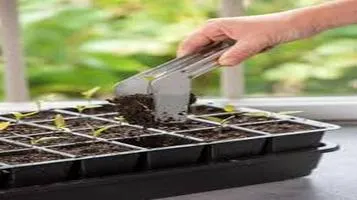Seed Starting Kits: A Gardener’s Best Friend
Seed starting kits are convenient and efficient tools designed for gardeners looking to cultivate plants from seeds. These kits typically include a selection of seed trays or pots, a growing medium such as peat pellets or soil discs, and often a humidity dome to create a mini greenhouse effect. Some advanced kits may also incorporate heating mats to maintain optimal soil temperature, promoting faster germination. Ideal for both novice and experienced gardeners, seed starting kits simplify the process of nurturing young plants, ensuring they receive the right conditions for healthy growth. They are perfect for starting a variety of plants, from vegetables and herbs to flowers, indoors before transferring them outdoors, providing an early start to the growing season and increasing the chance of successful cultivation.

Seed starting kits have become a staple for both novice and experienced gardeners alike. These kits offer an efficient and convenient way to jumpstart your gardening season, ensuring that your plants get the best possible start. Whether you're looking to grow vegetables, herbs, or flowers, seed starting kits can significantly enhance your gardening experience. In this review, we'll delve into the various aspects of seed starting kits, from their components to their benefits and drawbacks, to help you decide if they are worth the investment.
Components of Seed Starting Kits
Most seed starting kits come with a few basic components: seed trays, growing medium, and a humidity dome. Some kits may also include additional features like a heat mat, grow lights, or even pre-packaged seeds.
1. Seed Trays: These are usually made of plastic and come with individual cells to plant multiple seeds. The size of the cells can vary, allowing you to choose a kit that best suits the type of plants you want to grow.
2. Growing Medium: The growing medium can be peat pellets, coconut coir, or a soil-less mix. These mediums provide the necessary nutrients and structure for the seeds to germinate and grow.
3. Humidity Dome: This is a clear plastic cover that goes over the seed trays to maintain a moist environment. It helps in faster germination by retaining humidity and warmth.
4. Heat Mat: Some advanced kits come with a heat mat that can be placed under the seed tray to provide consistent warmth, an essential factor for seed germination, especially in colder climates.
5. Grow Lights: For those who do not have access to adequate natural light, some kits include grow lights that provide the necessary light spectrum for plant growth.
6. Pre-Packaged Seeds: Some kits come with pre-packaged seeds, making it even more convenient to get started. These seeds are usually curated to ensure high germination rates.
Benefits of Seed Starting Kits
1. Convenience: One of the primary advantages of seed starting kits is the convenience they offer. Everything you need is included in one package, saving you the time and effort of sourcing individual components.
2. Controlled Environment: These kits allow you to create a controlled environment for your seeds. The humidity dome and heat mat ensure that the seeds receive the right amount of moisture and warmth, which are crucial for germination.
3. Early Start: Seed starting kits enable you to start your garden indoors before the last frost date. This gives your plants a head start, allowing you to transplant stronger seedlings into your garden once the weather is favorable.
4. High Germination Rates: The controlled conditions provided by seed starting kits generally result in higher germination rates compared to planting seeds directly in the ground.
5. Cost-Effective: While the initial investment might seem high, seed starting kits can be cost-effective in the long run. Growing your plants from seeds is usually cheaper than buying established plants from a nursery.
Drawbacks of Seed Starting Kits
1. Plastic Waste: Most seed starting kits are made of plastic, which can contribute to environmental waste. Some companies are now offering biodegradable options, but these are still relatively rare.
2. Initial Investment: The upfront cost can be a deterrent for some gardeners, especially those who are just starting out. However, considering the long-term benefits, this may be a worthwhile investment.
3. Maintenance: While seed starting kits simplify the process, they do require some maintenance. You need to monitor the moisture levels and ensure that the seedlings are not getting too much or too little light.
4. Space Requirement: Depending on the size of the kit, you may need a dedicated space to set it up. This could be a challenge for those with limited indoor space.
Popular Brands
Several brands have made a name for themselves in the seed starting kit market. Some of the more popular ones include:
1. Jiffy: Known for their peat pellet-based kits, Jiffy offers a range of sizes and options suitable for different types of plants.
2. Burpee: Burpee's kits often come with high-quality growing medium and are well-regarded for their durability and effectiveness.
3. Park Seed: Park Seed kits often include biodegradable components and are praised for their eco-friendliness.
Conclusion
Seed starting kits are a fantastic tool for anyone looking to get a head start on their garden. They offer a convenient, controlled environment for seed germination, resulting in stronger and healthier plants. While there are some drawbacks, such as the initial cost and plastic waste, the benefits generally outweigh these concerns. Whether you're a seasoned gardener or a beginner, investing in a quality seed starting kit can make your gardening experience more enjoyable and successful.






